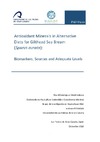Please use this identifier to cite or link to this item:
https://accedacris.ulpgc.es/jspui/handle/10553/73526
| Title: | Antioxidant minerals in alternative diets for gilthead sea bream (Sparus aurata) : biomarkers, sources and adequate levels | Authors: | Domínguez Montesdeoca, David | Director: | Izquierdo López, María Soledad Robaina Robaina, Lidia Esther |
UNESCO Clasification: | 251092 Acuicultura marina | Keywords: | Peces Dorada Alimentación Sparus aurata |
Issue Date: | 2019 | Project: | Advanced Research Initiatives For Nutrition & Aquaculture Consumer driven Production: Integrating Innovative Approaches for Competitive and Sustainable Performance across the Mediterranean Aquaculture Value Chain |
Abstract: | La industria de la acuicultura tiende a aumentar el uso de ingredientes vegetales en detrimento de ingredientes insostenibles derivados de la pesca. Este cambio acarrea alteraciones en el perfil mineral del pienso que aún no se han entendido completamente. La nutrición mineral de dorada ha recibido poca atención a pesar de su importancia en la acuicultura europea. La hipótesis de esta tesis fue que el uso de ingredientes vegetales en piensos para dorada puede afectar a los minerales dietéticos y sus niveles óptimos, y que el tipo de fuente mineral también puede afectar la utilización de minerales en la dieta.
En esta tesis se estudiaron el uso de fuentes para minerales antioxidantes (Mn, Se y Zn) en piensos con altos niveles de ingredientes vegetales. Además, se evaluaron los requisitos de Mn, Se y Cu en doradas alimentados con piensos prácticos.
Los resultados obtenidos de las experiencias con diferentes fuentes de minerales sugieren que se requiere la suplementación con óxido de Zn y selenometionina en piensos basados en harinas vegetales para mejorar la productividad y reducir el estrés oxidativo en dorada, mientras que la efectividad de métodos de encapsulación de minerales es reducida.
Los piensos basados en ingredientes de plantas pueden contener suficiente Mn para cubrir los requisitos de la dorada. Los niveles óptimos de la suplementación con Se son alrededor de 0.94 mg Se kg-1, mientras que un aumento de 1.00 mg Se kg-1 a 1.70 mg Se kg-1 produce toxicidad. No se requiere suplementación de Cu en las dietas para dorada a base de ingredientes vegetales, mientras que un contenido dietético de 11-32 mg de Cu kg-1, afectó negativamente el rendimiento de la dorada al reducir el crecimiento de los peces, aumentando el riesgo oxidativo e induciendo daño hepático y colestasis. The aquaculture industry tends to increase the use of plant ingredients to the detriment of unsustainable ingredients derived from fishing. This change leads to alterations in the mineral profile of the feed that have not yet been fully understood. Gilthead seabream nutrition has received little attention despite its importance in European aquaculture. The hypothesis of this thesis was that the use of vegetable ingredients in feed for sea bream can affect dietary minerals and their optimal levels, and that the type of mineral source can also affect the use of minerals in the diet. In this thesis the use of sources for antioxidant minerals (Mn, Se and Zn) in feeds with high levels of vegetable ingredients was studied. In addition, the requirements of Mn, Se and Cu in breams fed with practical feed were evaluated. The results obtained from the experiences with different mineral sources suggest that supplementation with Zn oxide and selenomethionine is required in feed based on vegetable ingredients to improve productivity and reduce oxidative stress in gilthead seabream, while the effectiveness of methods of encapsulation of minerals is reduced. Feed based on plant ingredients may contain enough Mn to meet the requirements of the bream. The optimal levels of supplementation with Se are around 0.94 mg Se kg-1, while an increase of 1.00 mg Se kg-1 to 1.70 mg Se kg-1 produces toxicity. Cu supplementation is not required in sea bream diets based on plant ingredients, while a dietary content of 11-32 mg of Cu kg-1 adversely affected the performance of gilthead sea bream by reducing fish growth, increasing the oxidative risk and inducing liver damage and cholestasis. |
Description: | Programa de doctorado: Acuicultura sostenible y ecosistemas marinos | Institute: | IU de Investigación en Acuicultura Sostenible y Ec | URI: | https://accedacris.ulpgc.es/handle/10553/73526 |
| Appears in Collections: | Tesis doctoral |
Page view(s)
611
checked on May 31, 2025
Download(s)
394
checked on May 31, 2025
Google ScholarTM
Check
Share
Export metadata
Items in accedaCRIS are protected by copyright, with all rights reserved, unless otherwise indicated.
